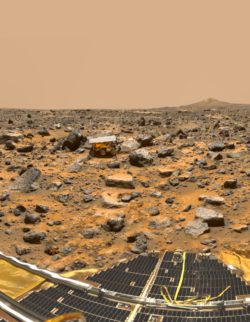Modelling Meteoric Metals in the Upper Atmosphere of Mars

Pathfinder on Mars
The ablation of cosmic dust particles during entry into a planetary atmosphere injects a variety of metal atoms at around the 1 mbar pressure level (Plane et al. 2018 SSRv 214:23). Recent measurements with two instruments on NASA’s MAVEN spacecraft have provided observations of meteoric metals in the Martian atmosphere, the first observations in a planetary atmosphere other than Earth’s (Grebowsky et al. 2017 GRL 44:3066; Crismani et al. 2018 Nat. Geo. 10:401). Furthermore, MAVEN arrived at Mars just before Comet Siding Spring made a close fly-by, providing the unique opportunity to observe the impact of a huge injection of cometary dust into a planetary atmosphere (Benna et al. 2015 GRL 42:4670; Schneider et al. 2015 GRL 42:4755; Crismani et al. 2018 JGR 123:2613). Understanding the chemistry and global transport of metallic species in the upper atmosphere of Mars is the overarching objective of this proposal. We shall:
1) simulate - for the first time - Mg, Fe and Na simultaneously and self-consistently in a global model of Mars extending up to 200 km;
2) run the model for the period of MAVEN observations (2014 – present) and compare the diurnal, seasonal and latitudinal distribution of neutral and ionized metals with MAVEN observations; 3) simulate the Siding Spring encounter and compare with MAVEN observations of the evolution of metallic species over the 2 days following the event.
This project is funded by the UK Science and Technology Facilities Council. The investigators are John Plane, Dan Marsh and Wuhu Feng. The project partners are project partners are Nick Schneider (U. Colorado, Boulder) and Matteo Crismani (NASA GSFC), Mehdi Benna (NASA GSFC) and Francisco González-Galindo (Instituto de Astrofísica de Andalucía, Granada).
